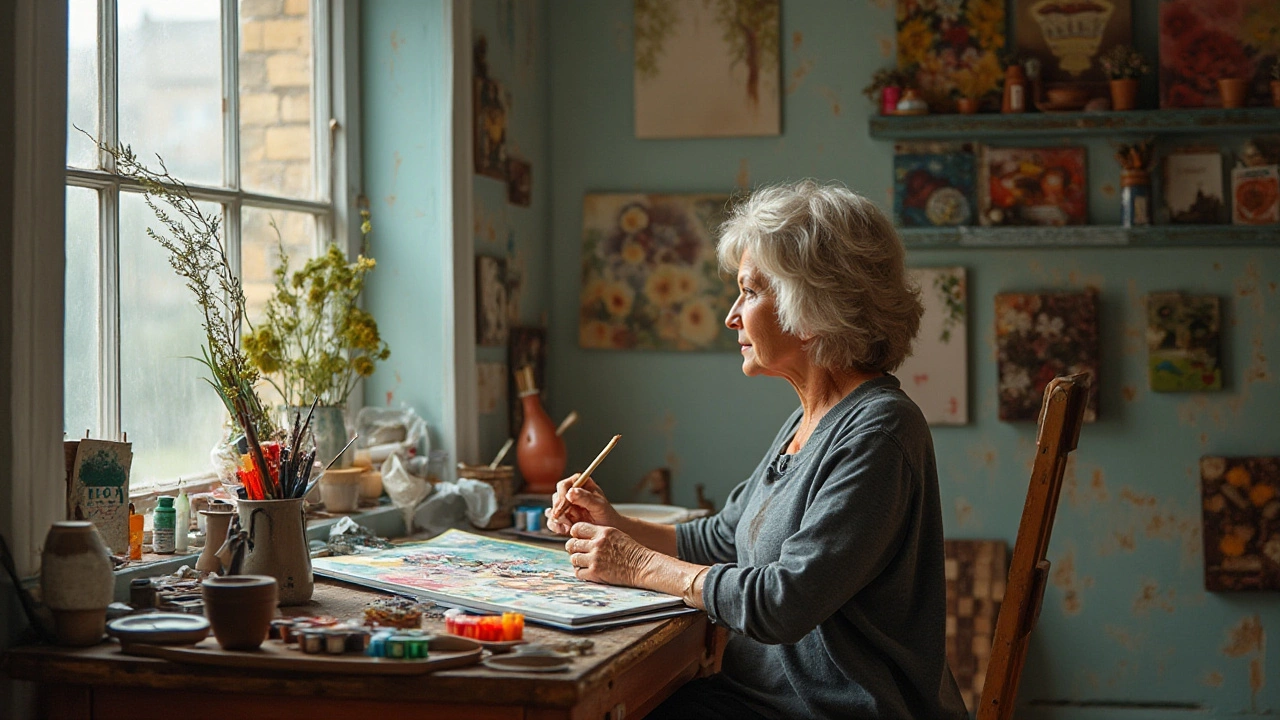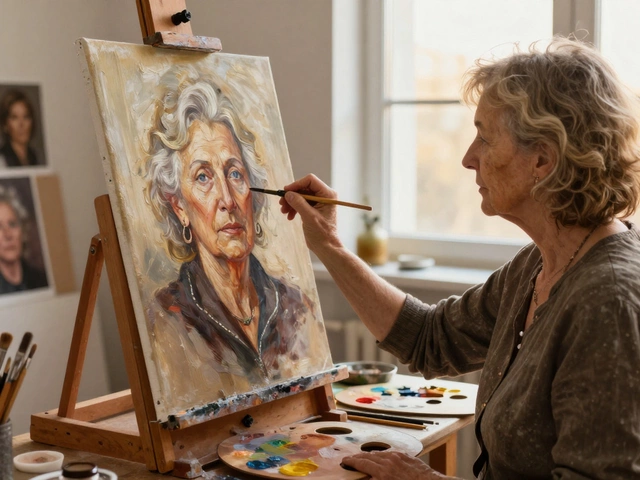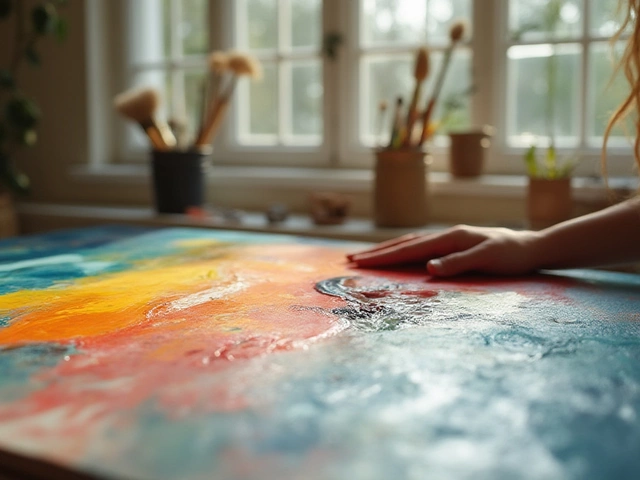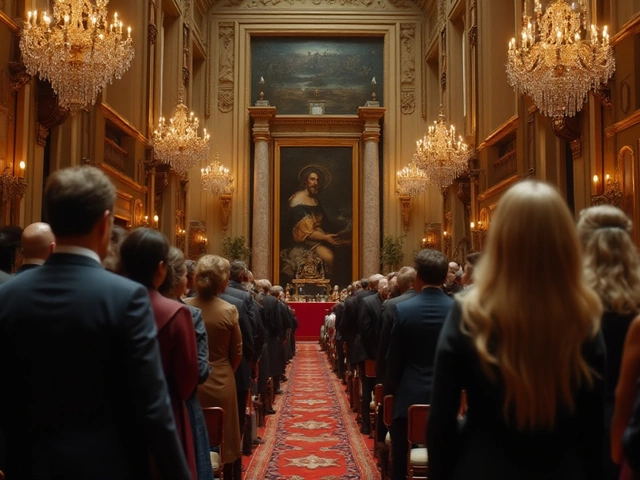Oil painting captivates with its rich texture, depth, and vibrant colors, drawing many aspiring artists into its world. While traditional art education offers structured learning paths, many have found joy and fulfillment by exploring this medium independently. But can you truly teach yourself to paint with oils?
The answer is a resounding yes. With patience, practice, and a touch of curiosity, self-learning oil painting is not only possible but often leads to a rich, rewarding experience that feels uniquely your own. Whether you're captivated by the swirling skies of Van Gogh or envious of Monet's lush gardens, self-learning opens doors to endless creative expressions.
Understanding the basic tools and techniques will set you on the right path. From choosing the right brushes to mixing colors that sing, learning oil painting on your own is a gratifying endeavor. Through this article, we’ll explore everything from the must-have materials to exercises that help you build confidence and skill. So grab your palette, because the canvas is waiting for your touch!
- The Essential Supplies for Beginners
- Understanding Oil Paints and Mediums
- Foundational Techniques to Explore
- Developing Your Unique Style
- Challenges and Troubleshooting
- Practical Exercises to Hone Your Skills
The Essential Supplies for Beginners
Embarking on your oil painting journey can be thrilling, but without the right supplies, it might feel daunting as well. Unlike some other painting mediums, oil painting requires specific tools that will help you achieve the best results and unleash your creativity without unnecessary limitations. The first step is selecting quality paint. It's wise to opt for a balanced starter set that includes primary colors and a few earth tones. These basics can be mixed to produce any hue you need, which not only saves money but also teaches valuable color-mixing skills. A good brand to start with is Winsor & Newton or Gamblin, known for their rich pigments and consistent quality, making them a favorite among self-learners.
Brushes are next on the shopping list, and here, variety is key. Look for a set that includes filberts, flats, and rounds. Each type offers different stroke versatility which is essential in mastering texture and detail in your artwork. Royal & Langnickel or Princeton are reputable brands and have strong, durable bristles that stand up to rigorous use. Don't forget a palette for mixing. A glass or wood palette gives a traditional feel, but disposable paper palettes offer convenience for quick clean-ups. It's these little choices that tailor an environment conducive to focused creativity.
Canvas selection also plays an integral role in oil painting. For beginners, pre-stretched and primed canvases are the easiest route. They are ready to paint and offer the structure and durability necessary for consistent practice. Canvas panels are a suitable alternative for those who prefer a sturdier feel. Now, let’s not overlook the need for a good easel—aligning with one that is adjustable and sturdy ensures comfort in long painting sessions. Finally, have linseed oil and turpentine or odorless mineral spirits on hand. These mediums modify paint texture and drying time, bringing versatility to your technique.
Interestingly, a recent survey by Art Supplies Center found that beginners who invest in quality materials often remain committed to oil painting longer compared to those who start with inferior products. A simple table below illustrates the average costs of essential materials for a beginner:
| Item | Approximate Cost ($) |
| Oil Paint Set | 50-80 |
| Brush Set | 20-40 |
| Canvas | 10-30 |
| Palette | 10-20 |
| Easel | 40-100 |
As the famous artist Bob Ross once remarked,
"We don't make mistakes, just happy little accidents."This is particularly true in art, where the tools you choose can significantly enhance your learning experience. With the right supplies and mindset, those ‘accidents’ become stepping stones to mastery. Start with solid tools, and you will lay a strong foundation for your artistic journey.
Understanding Oil Paints and Mediums
The allure of oil painting lies not only in its visual appeal but also in the tactile pleasure it offers to painters. To truly appreciate this medium, it's essential to delve into the characteristics of oil paints and the accompanying mediums. Oil paints, unlike other paints, are made by binding pigments with oil, traditionally linseed, which gives them their distinct qualities. These paints are slow-drying, allowing for meticulous blending and layering, which is ideal for capturing subtle gradients of color and depth. This quality makes them a favorite among artists who prefer to work and rework their paintings over time.
One can't discuss oil paints without considering the importance of color permanence and texture. The richness of oil paints comes from their ability to maintain vibrant hues, which do not easily fade, allowing your artwork to stand the test of time. However, this longevity also depends on choosing high-quality paints. Artist-grade paints, though more expensive, contain a higher concentration of pigment with fewer additives, ensuring true colors and a superior finish. An interesting aspect of oil paints is the wide variety of textures they offer, from creamy and translucent layers to thick impasto techniques, each offering artists a different way to express their creativity.
Mediums are equally indispensable in expanding the versatility of oil painting. They offer artists a broad spectrum of effects, from altering the consistencies to modifying drying times. Traditional mediums, such as linseed oil, can make your paint smoother and more fluid, enhancing the ability to work with intricate details. As for faster alternatives, alkyd mediums can speed up the drying process, which might be vital for artists who have deadlines or want to apply multiple consecutive layers. There are also impasto mediums designed specifically for adding volume to your brushstrokes, allowing the canvas to speak with bold, pronounced textures.
Cezanne once said, "Oil painting is the harmony parallel to nature." This harmony often requires a comprehensive understanding of how paints and mediums interact. Experimentation is key; the choices of mediums and supports can greatly impact the overall tone and feel of your artwork, guiding the viewer's eye and emotion.Incorporating self-learning, engaging in experimental exercises with these media can be enlightening. Start by painting simple subjects and playing with various medium ratios to observe changes in texture, sheen, and workability. Documenting these experiments will not only help you refine your personal technique but also make your creative process more intentional.
A deeper exploration can include using natural or synthetic sands mixed with mediums to yield texture or employing glazing techniques to create luminous effects. Head to your local art supplier and request advice on trying out such combinations on different surface types. In doing so, you might not only uncover technical proficiency but also discover new avenues for your creativity, as the oils and mediums dance together under your stewardship, forever transforming the canvas in extraordinary, vibrant ways.
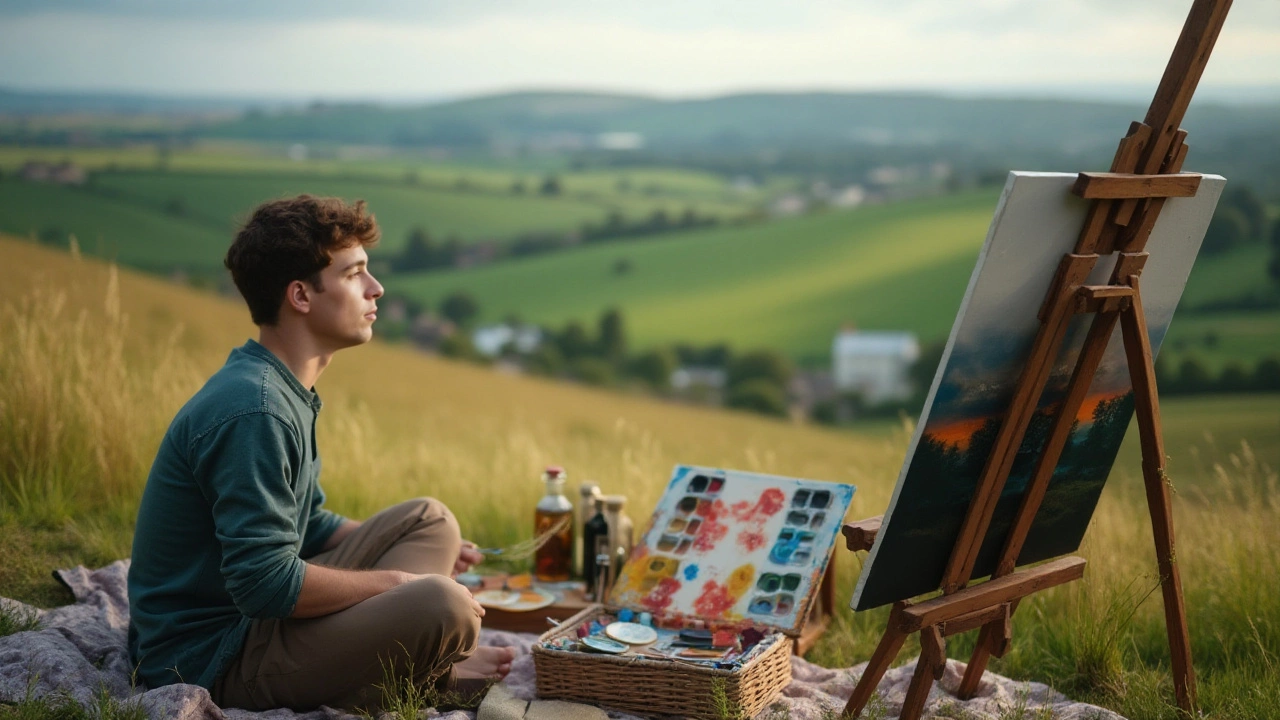
Foundational Techniques to Explore
Starting on your oil painting journey involves understanding and mastering some foundational techniques. These basics not only teach control and skill but also pave the way for personal expression in your work. One can think of these techniques as the building blocks that lead to artistic mastery; without a solid grasp of them, creating the artwork you envision can be challenging.
This journey begins with understanding the concept of underpainting, a technique used by many artists to outline their compositions. Often executed using paint thinners like turpentine mixed with paint, this first layer sets the stage for your piece. It assists in providing a structure to your painting and can be approached in tonal values using a single color or multiple shades of complementary hues. Notably, underpainting can greatly influence the tonal balance of the finished work, helping to bring depth and coherence.
Color mixing is another pivotal skill in your oil painting toolbox. Mastering this allows you to capture the myriad of shades and tones seen in nature or imagined from your mind. One effective exercise involves creating a color wheel using primary oils. As you mix these primary colors to create secondary and tertiary hues, you'll gain a deeper understanding of color relationships. Doing this will help in achieving harmony and contrast within your work.
“Mixing colors is the skill of recognizing the emotional tone the painting must convey,” said renowned artist and educator, David Leffel.
Another useful approach involves glazing, where thin, transparent layers of paint are applied upon already dry layers. This technique delivers a luminosity that is difficult to achieve with thick paints. Each layer modifies the appearance of color and texture, and with careful planning, you can control the intensity and mood of your artwork. Experimenting with glazing will allow for a transformed perspective on how light interacts with paint.
Palette knife technique offers a different range, helping create thick textures that enhance a painting's physical presence. By using a palette knife, you can achieve bold strokes and tactile surfaces, adding dimension and a sculptural quality. This technique is especially effective when painting landscapes or abstract compositions that benefit from a dynamic background or specific surfaces.
Lastly, because control over the painting process is crucial, practicing brushwork refinement is important. Your choice of brush and how you manipulate it can drastically change the outcome. Whether using a flat brush for broad strokes or a smaller round brush for intricate details, adapting your brushwork will enable you to achieve varied textures and effects within a single painting. Pay attention to the application of pressure and direction when applying paint to canvas.
The journey involves understanding these key techniques and the confidence to experiment with them in unison. Committing hours to practice and exploration while maintaining a curious mind becomes the essence of self-learning in oil painting. Whether it's through trial and error or structured exercises, the pursuit gradually unveils the vast potential held within even the simplest of tools—paintbrush and color.
Developing Your Unique Style
Finding your voice in the world of oil painting is akin to embarking on a journey of self-discovery. Your unique style is essentially how you communicate through your art, and it's rooted deeply in the choices you make regarding subjects, colors, textures, and influences. Initially, it might seem daunting, especially when faced with the shadows of historical greats like Rembrandt or modern maestros. However, the process of developing a personal style is less about reinventing the wheel and more about understanding what resonates within you as an artist.
One method to start uncovering your style is to embrace what naturally attracts you. Pay attention to the subjects that pique your interest, be it landscapes, portraits, or abstract forms. Reflect on color palettes that speak to your emotions or the textures that you find appealing. At times, this might mean deviating from conventional norms or even stepping out of the comfort zone of predefined art styles. Remember that many renowned artists, such as Picasso and van Gogh, developed their distinctive styles by evolving from traditional techniques and adding their own personal flair. Finding a style doesn't mean sticking to one genre; it’s about merging elements that collectively define your artistic identity.
Oil painting offers a vast playground of techniques that can significantly enrich your artistic expression. Techniques such as impasto, where paint is laid impromptu thickly on the canvas, can add depth and dimension, allowing for a textural exploration of light and shadow. Alternatively, you might be drawn to the luminosity created by glazing, a method of applying thin transparent layers of paint to create depth. Understanding and experimenting with these techniques can be instrumental in shaping your style. As you dive into different techniques, document your journey. Keep a sketchbook or a digital journal where you note what works for you and what doesn’t.
A World of Inspiration
It’s beneficial to expose yourself to the art world around you. Visit galleries, delve into art history books, and follow artists on social media. Engaging with a variety of styles and periods not only broadens your understanding but helps you refine your personal preferences. Art critic Robert Hughes once said, "The greater the artist, the greater the doubt. Perfect confidence is granted to the less talented as a consolation prize."Engaging with this doubt is part of embracing your creative self, encouraging exploration and accepting the evolving nature of your style.Often, inspiration from diverse sources amalgamates into a style peculiarly and wonderfully your own.
Finding Your Fit
Be patient and forgiving with yourself during this process. Your style will solidify through consistent practice, reflection, and the willingness to make mistakes. Take time to analyze why certain paintings resonate more, which techniques you find most invigorating, or what thematic elements continue to recur in your work. This process cannot be rushed. Art has always been an iterative process, and experimentation often paves the rough road to originality. Embrace it.Here’s an interesting data table that might help in identifying some common characteristics of emerging art styles today:
| Style | Color Palette | Key Techniques | Popular Subject Matter |
|---|---|---|---|
| Minimalism | Neutral, Pastel | Flat Application | Abstract, Shapes |
| Impressionism | Bright, Bold | Short Brush Strokes | Nature, Landscapes |
| Realism | Earthy, Nature-Inspired | Blending, Detailing | Everyday Scenes |
In the quest for your artistic voice, remember that consistency in practice is pivotal. Dive into exercises that not only stretch your technical skills but also encourage introspection about your preferences. Each brushstroke on the canvas is a step towards uncovering a style that is unmistakably yours. Embrace this exploration as an integral part of your journey in self-learning oil painting. As you navigate through this process, relish in the understanding that your style is a living entity—ever-changing and perpetually maturing.

Challenges and Troubleshooting
Delving into the world of oil painting can be an exhilarating but sometimes bewildering experience, especially for those deciding to learn independently. One of the first hurdles artists face is grappling with the very nature of oil paints—their slow drying time. While this offers the advantage of blending colors over extended periods, it can also lead to unintended smudging or unwanted mixing, especially for those used to quicker-drying mediums. To prevent this, consider working in layers and giving previous ones ample time to dry. You might initially resist but committing to patience in this stage can significantly improve the quality of your finished work. Understanding the balance between wet and dry areas on your canvas is crucial in avoiding muddied colors or undefined textures.
Another common challenge lies in mastering the variety of textures and finishes that oil paints can create. Achieving a desired texture often requires experimenting with different application techniques and mediums. It's vital to familiarize yourself with techniques like glazing or scumbling, each lending a unique effect to your canvas. Novice artists may initially struggle with brush care and selection, too. A high-quality bristle brush can dramatically impact the outcome of your strokes. To keep them in optimal condition, always clean them thoroughly with mineral spirits or specially designed brush cleaners.
"The magic of oil painting lies in the layers of light it captures," says renowned artist and instructor Bob Ross. "But every artist will humbly admit that it takes time to really see that magic."
It's not uncommon for beginners to also struggle with mixing colors precisely, which is an essential aspect of painting. One helpful technique involves limiting your palette to primary colors and gradually expanding as you gain confidence. Start simple, understand color theory basics, and learn to see the subtle hues within everyday surroundings. A frequent pitfall is misunderstanding how oil paints darken over time due to their drying process, which can affect overall color balance when not planned correctly. To mitigate this, conduct test samples of your mixes on scrap paper and let them dry before including them in your main work.
Understanding the intricate world of mediums and additives represents another common difficulty. These can enhance drying times, gloss, and texture but can also overwhelm if overused. Always remember that less is more with any additive—begin with small amounts and observe their effects. Accidents and mistakes will happen, that's a given. Instead of seeing them as failures, view them as opportunities to discover techniques uniquely yours. Albert Einstein once said, "A person who never made a mistake, never tried anything new," and this is especially true in the dynamic world of oil painting. Overcoming the fear of making a mistake is pivotal for self-learning artists pressing forward with confidence and creativity.
Practical Exercises to Hone Your Skills
Diving into hands-on exercises is a powerful way to enhance your mastery of oil painting. As you explore the medium, regular practice will build not just technical skill but also confidence. One essential exercise for every budding artist is creating a color chart. This involves painting strips of your oil paints in varying mixtures, from pure colors to blends with hues like white or black. By doing this, you familiarize yourself with the tonal range and color variations possible with your palette. The process also aids your understanding of color relationships, which is crucial for achieving depth and realism in your work.
Another valuable exercise is replicating famous artworks. This doesn’t mean directly copying another’s work, but interpreting it through your lens. Attempting to recreate the textures of Van Gogh or the serene light of Monet challenges your brushwork and understanding of lighting, composition, and texture. Don’t be discouraged by perceived imperfections—this exercise is as much about exploration as refinement. Remember, even great artists started somewhere, experimenting and learning from what resonates with them.
To refine your techniques further, try painting simple still-life compositions. Set up a small scene with everyday objects, focusing on basic shapes, contrasting colors, or the way light falls. This exercise enhances observational skills, teaching you to see intricate details in ordinary subjects. As you paint, experiment with various art techniques, such as glazing or scumbling, to add depth to simple setups. Focusing on everyday compositions builds the intuition needed to tackle more complex pieces.
In addition to traditional methods, don't shy away from utilizing digital tools. Recording yourself as you paint and rewatching the footage can provide critical insights into your technique. This method allows you to observe your own workflow, identifying moments where you could simplify or enhance steps. Online forums and communities can also be a useful resource if you're looking to exchange critiques with fellow self-learners. Sharing experiences provides new perspectives and could even spark collaborations with other painters who self-learn oil painting techniques.
Incorporate plein air painting into your routine to develop your ability to capture scenes quickly and efficiently. Painting outdoors introduces dynamic subjects, from changing light to active surroundings, forcing you to think on your feet. Working in varied weather conditions hones adaptability—a vital skill for any artist. As Charles Webster Hawthorne once said, "The object isn't to make art, it's to be in that wonderful state which makes art inevitable." Set out with a travel easel and experience the unique challenge and reward of creating art in natural, changing environments.
Finally, maintaining a sketchbook dedicated to self-learning initiatives is invaluable. Use it to document your progress, jot down ideas, and plan compositions. Regular entries foster a habit of continual learning, offering a reflective practice that helps track improvement over time. It isn’t merely about final pieces; capturing loose ideas encourages creativity, providing a space for experimentation without fear of making mistakes. Remember, every great artist has made use of various methods, honed with practice, that resonate most with their individual journeys.
